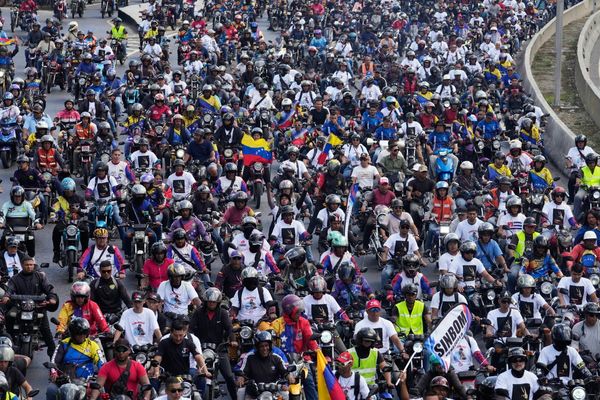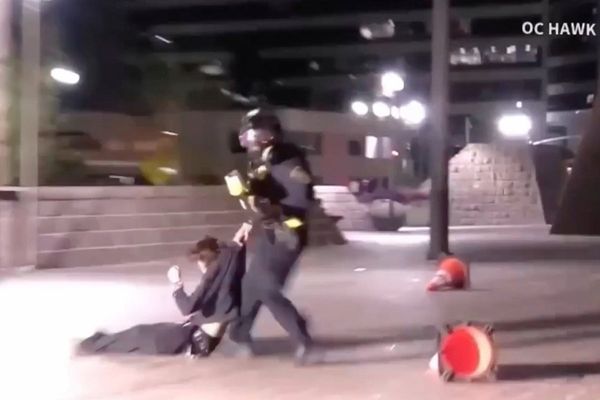A lobbying blitz is expected this month from advocates for the untold thousands of Americans harmed by radiation from government nuclear projects dating back to World War II, starting with development and testing of the first atomic bomb.
Senators pushing to expand aid for radiation victims were infuriated in December when a provision to reauthorize a compensation fund that expires in June was stripped from the 2024 National Defense Authorization Act prior to Senate passage, largely because of concerns about the projected price tag: $147 billion over 10 years.
Now groups ranging from a coalition of mothers in the St. Louis area to the Navajo Nation are planning visits to Capitol Hill to demand expansion and a longer renewal of the Radiation Exposure Compensation Act, a 1990 law that provided aid to uranium workers and those exposed to any of nearly 200 nuclear tests in Nevada between 1945 and 1962. The law did not cover those exposed to the first nuclear detonation in White Sands, N.M., in 1945.
Under RECA, which was extended for two years in June 2022, workers who mined or transported uranium before 1971 and contracted certain cancers and other diseases are entitled to $100,000; participants sickened by the weapons tests could receive $75,000; and those who lived downwind in parts of Nevada, Utah and Arizona and were harmed are eligible for $50,000.
As “Oppenheimer” hit movie theaters in July and raised awareness of the impacts of the atomic bomb’s development, the Senate voted 61-37 to add a proposal to expand and extend RECA to the annual defense authorization bill.
The plan from Sens. Josh Hawley, R-Mo., and Ben Ray Luján, D-N.M., would reauthorize RECA for 19 years and expand eligibility for compensation to the following:
- More residents of Nevada, Utah and Arizona
- Residents of New Mexico, Colorado, Idaho, Montana and Guam, where people were exposed to tests in the Pacific Ocean
- Uranium workers after 1971
- Veterans who cleaned up radioactive wastes in the Marshall Islands
- People affected in the St. Louis area, where uranium was processed starting in the 1940s
But before the Senate voted 87-13 to pass the defense authorization bill on Dec. 14, the House-Senate conference committee removed the RECA provisions. No one said so publicly, but advocates for higher victim compensation said members were spooked by a Congressional Budget Office report that projected the cost at $147.1 billion over 10 years. That would nearly equal the bulk of the estimated $153.5 billion in increased budget outlays over the same decade from the Senate version of the NDAA.
Hawley threatened to block passage of the defense bill and expressed his outrage on the Senate floor on Dec. 12.
“This is a grave injustice,” he said. “When the government causes injury, the government should make it right. … That’s what the radiation compensation program does — and it’s wrong to let it expire. … It is a scar on the conscience of this body and of this nation.”
Aides to Hawley and Luján worked through the Christmas break on a strategy for bringing the RECA reauthorization back to the floor. The senators are “considering all potential legislative vehicles, continuing to work to build GOP support, and looking at different approaches to get something meaningful done,” said Katherine Schneider, communications director for Luján.
“Congress has left behind Americans who’ve developed illnesses at the hands of their own government’s nuclear waste for decades, and time to compensate them is running out,” Hawley said in an emailed statement. “I am working to get RECA’s reauthorization across the finish line, and I’m ready to use every tool at my disposal in 2024 to do it.”
Advocates are awaiting details so they can start stepping up pressure on lawmakers.
“We’re planning a trip to D.C. in the next couple of weeks,” said Dawn Chapman, co-founder of Just Moms STL, by phone from St. Louis last week. Her group has long been seeking compensation for exposure to radioactive wastes from uranium processing in the St. Louis area in the 1940s and 1950s.
Chapman said only about $4 billion of the $147 billion in added compensation costs would likely go to her community, but her group does not want to push for separate legislation just to help victims in Missouri.
“This has been happening to communities across the country, and we believe we all need to stay united,” she said.
‘Blatant act of injustice’
A bigger share of the aid would go to people affected by radioactive clouds in the Southwest during the decades of testing, including many Native Americans, as well as workers in uranium mining and transport from the 1940s to the 1980s.
About 5,000 Navajo people worked in the uranium mines, where they were exposed to radon gas, radioactive dust and contaminated water, said Justin C. Ahasteen, executive director of the Navajo Nation Washington Office, via email.
“The fallout from this uranium boom was catastrophic,” he said. “The Navajo people have borne the brunt of the health and environmental consequences, with increased rates of lung cancer, kidney disease, and birth defects. Yet, for decades the federal government denied any responsibility for the health crises that grew out of uranium mining.”
Ahasteen called the decision not to reauthorize RECA “a blatant act of injustice. … The conditions these miners worked under were already unconscionable; to deny them and their descendants’ compensation for the resulting health issues is beyond morally indefensible.”
He also disputed the CBO’s cost estimate, noting that the government has paid out less than $5 billion in RECA compensation in the past 20 years. “To suggest that this will increase to $150 billion is outrageous. We believe that the cost would be roughly 10 billion dollars.”
Scores of other groups representing victims of radiation have been advocating for expansion of the compensation fund for years; many of them signed onto a letter organized by the Union of Concerned Scientists that was sent to congressional leaders in July.
“Impacted communities were unknowingly on the frontlines of World War II and the Cold War, ” the letter said. “It is a tragic fact that, in an effort to protect us from our enemies, the U.S. government poisoned its own people. We must honor those who sacrificed their health for our country’s national security.”
Lilly Adams, senior outreach coordinator in the Global Security Program at the UCS, said in an email last week that it’s hard to estimate how many people would be eligible for aid because the government has never monitored for health effects or exposures.
“But ultimately this is not about numbers, it’s about people,” Adams said. “It’s about taking care of the communities that were unknowingly exposed to toxic/deadly radiation by our government.
“The cost of chemotherapy, surgeries and end of life care is already being borne by Downwinders, miners, and those poisoned by the Manhattan Project,” she added. “The cost of this program is a fraction of what the U.S. government has spent — and continues to spend – on the nuclear weapons that created this mess.”
During a visit to Belen, N.M., in August, President Joe Biden expressed support for increased compensation. “I’m prepared to help in terms of making sure that those folks are taken care of,” Biden said in response to a pitch from Luján.
Hawley and Rep. Cori Bush, D-Mo., have been especially active in seeking aid for victims in the St. Louis area, where radioactive wastes from uranium processing were dumped for decades at several sites and contaminated a creek in the northern suburbs.
A Government Accountability Office report requested by Bush and released in October said much of the contamination is in underserved communities. Additionally, the Army Corps of Engineers needs to improve its communications about a cleanup that is expected to continue until 2038, GAO said.
Hawley has demanded testing for radioactive contamination at an elementary school that sits in the middle of the poisoned creek’s floodplain.
Pressure for action intensified in July when the Missouri Independent, non-profit news organization MuckRock and the Associated Press published an extensive investigative report on threats posed by exposure to contamination in the St. Louis area since at least 1949.
The post Victims of nuclear weapon development plan Hill barrage appeared first on Roll Call.







